Marathi Bhakri and Thecha
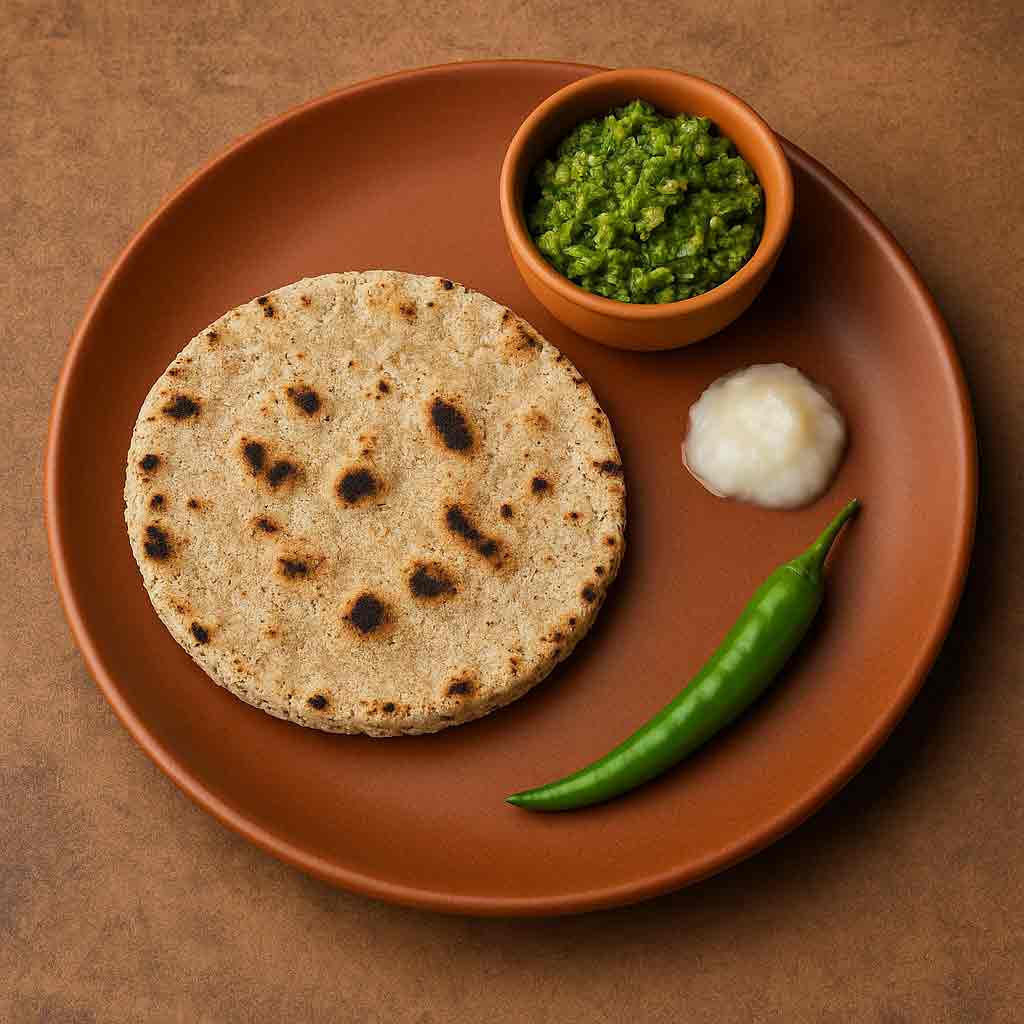
Marathi Bhakri and Thecha A staple of rural Maharashtra, this simple yet bold meal celebrates earthy flavors, coarse grains, and fiery spice — comfort food at its purest. 🫓 Part 1: Bhakri (Millet Flatbread) 🧂 Ingredients: Jowar (Sorghum) flour – 1 cup(You can also use Bajra (Pearl Millet) or Nachni (Ragi) flour for variation) Hot water – about ¾ cup Salt – ¼ tsp (optional) Ghee or butter – for serving 👩🍳 Preparation: Boil water: Heat water till it starts bubbling, then switch off the flame. Make dough: Add salt and gradually mix in jowar flour using a spoon (as water is hot). Once it cools slightly, knead into a soft dough while it’s still warm. Shape the bhakri: Take a small ball of dough. Flatten it using your palms on a flat surface, lightly dusted with dry flour. Gently press and spread it into a round disc about 6–7 inches wide. Cook: Heat a tawa (griddle). Place the bhakri and cook one side until small bubbles appear. Flip and cook the other side, pressing gently with a cloth or spatula until light brown spots appear. Optionally, puff it directly on the flame for 5–10 seconds. Serve hot with a dollop of ghee or butter on top. 🌶️ Part 2: Thecha (Spicy Green Chili Garlic Chutney) 🧂 Ingredients: Green chilies – 10–12 (adjust spice level to taste) Garlic cloves – 6–8 Peanuts (optional) – 2 tbsp Coriander leaves – a small handful Salt – to taste Oil – 1 tbsp (preferably groundnut or sesame oil) 👩🍳 Preparation: Roast the chilies:Heat oil in a small pan. Add green chilies and garlic. Sauté until blistered and aromatic.(You can also roast them on open flame for smoky flavor.) Add peanuts:Toast lightly till golden, if using. Grind:Using a mortar and pestle (traditional method), crush all ingredients coarsely.You can also use a mixer grinder — pulse briefly, don’t make it smooth. Add coriander and salt:Mix well. Adjust seasoning as per taste. Thecha should be coarse, spicy, and punchy — the true Marathi way! 🍽️ Serving Suggestion: Serve hot Bhakri with Thecha, a dollop of curd or white butter, and sometimes with a side of onion slices or dry peanut chutney.This combination pairs beautifully with: Pithla (Gram flour curry) Zunka (dry chickpea flour stir-fry) Matki usal (sprouted beans curry) 🌾 Pro Tips for Authentic Flavor: Use earthen or cast-iron tawa for the perfect texture. For variation, make garlic-red chili thecha by replacing green chilies with dry red ones. Don’t over-grind thecha — its chunky texture is its identity.
Marathi Misal Pav
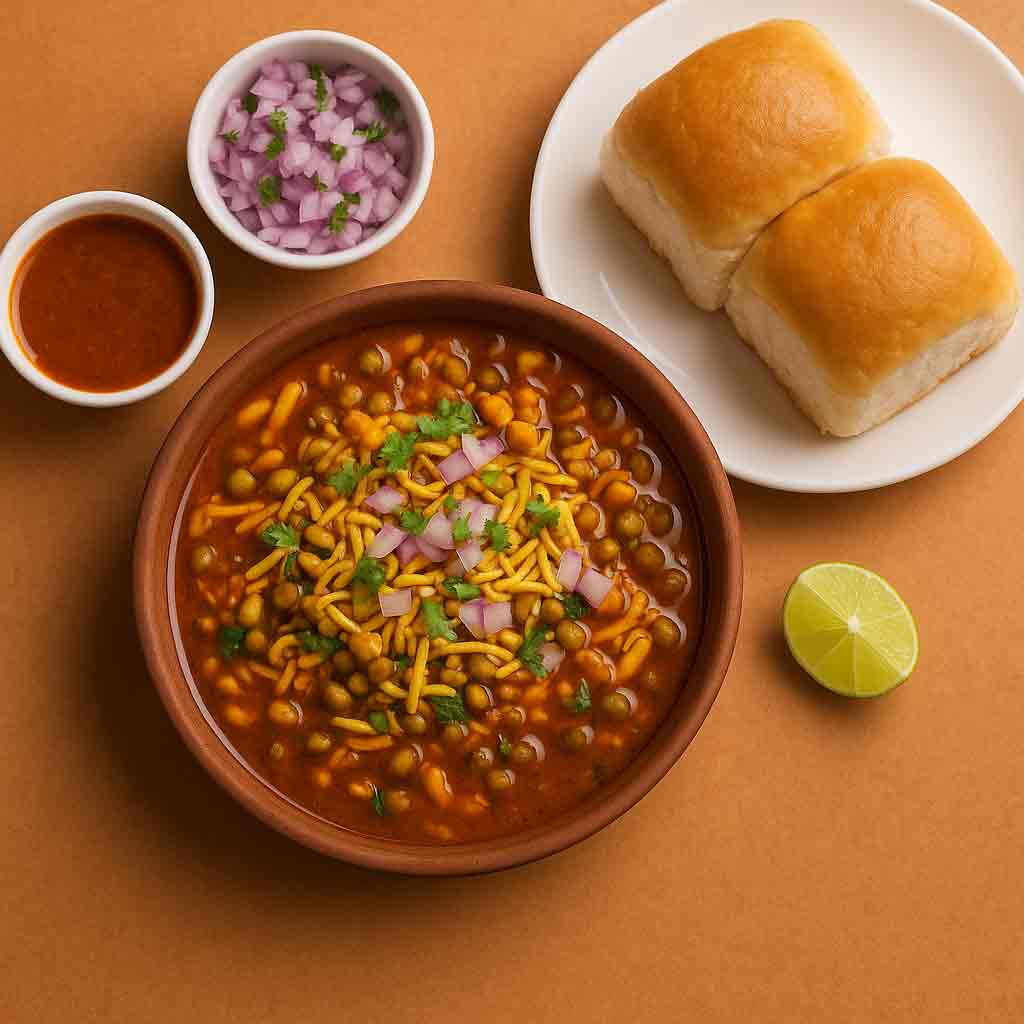
Marathi Misal Pav Misal Pav combines misal (a spicy curry made from sprouted beans) with pav (soft bread rolls) and a variety of toppings like farsan, onions, and lemon. It’s a complete meal bursting with flavor, texture, and aroma. 🫘 Ingredients For the Usal (Sprout Curry) Moth beans (matki) – 1 cup (sprouted) Onion – 1 medium (finely chopped) Tomato – 1 medium (chopped) Ginger-garlic paste – 1 tsp Green chili – 1 (chopped) Mustard seeds – ½ tsp Cumin seeds – ½ tsp Curry leaves – 8–10 Turmeric powder – ¼ tsp Red chili powder – 1½ tsp Coriander powder – 1 tsp Goda masala (or garam masala) – 1 tsp Salt – to taste Oil – 2 tbsp Water – 1½ cups For the Kat / Tarri (Spicy Red Curry) This gives Misal its fiery punch 🔥 Onion – 1 large (chopped) Tomato – 1 large (chopped) Dry red chilies – 3 Garlic cloves – 4 Ginger – 1 inch Grated coconut – 2 tbsp (optional but authentic) Red chili powder – 2 tsp Goda masala – 1 tsp Oil – 3 tbsp Salt – to taste For Serving Pav (soft bread rolls) – 8 pieces Farsan (mixture/sev) – 1 cup Chopped onion – 1 cup Chopped coriander leaves – ½ cup Lemon wedges – to serve 👩🍳 Preparation Steps 🌱 Step 1: Sprouting the Beans Soak moth beans overnight. Drain, wrap in a damp cloth, and keep in a warm place for 8–10 hours to sprout. 🍛 Step 2: Make the Usal Heat oil in a pan. Add mustard seeds and cumin seeds; let them splutter. Add curry leaves, onions, and green chili. Sauté until golden. Add ginger-garlic paste and fry till the raw smell disappears. Add tomatoes, turmeric, chili powder, coriander powder, and goda masala. Add sprouted moth beans and salt. Stir well. Pour water, cover, and cook for 10–15 minutes till the beans soften and the curry thickens slightly. 🌶️ Step 3: Prepare the Kat / Tarri (Spicy Gravy) Heat oil in another pan. Sauté onions until dark brown. Add garlic, ginger, and dry red chilies; fry well. Add tomatoes and cook until soft. Add coconut, chili powder, and goda masala; sauté until oil separates. Blend this mixture into a smooth paste using little water. Return it to the pan, add salt and water as needed, and simmer for 5 minutes.This forms the bright red, spicy layer that floats over the misal. 🍽️ Step 4: Assemble Misal Pav In a serving bowl, add a portion of usal (sprouts curry). Pour a ladle of kat/tarri over it for that signature spice. Top with chopped onion, farsan, and coriander. Squeeze fresh lemon juice on top. Serve hot with toasted pav on the side. 🧡 Optional Additions Add a dollop of curd for a milder flavor. Serve with buttermilk or solkadhi to balance the heat. Some regions (like Kolhapur) serve an extra bowl of tarri on the side for spice lovers. 🌟 Tips for Authentic Marathi Flavor Use Kolhapuri Masala for extra punch if available. Goda masala adds depth — don’t skip it. The tarri should float on top — that’s how true Kolhapuri Misal is served. 🧂 Serving Style Traditionally, Misal Pav is served in two layers — the base of sprouts (usal) topped with a fiery tarri — garnished generously with farsan, onion, and coriander. The pav is lightly buttered and toasted before serving.
Kerala Malabar Biryani
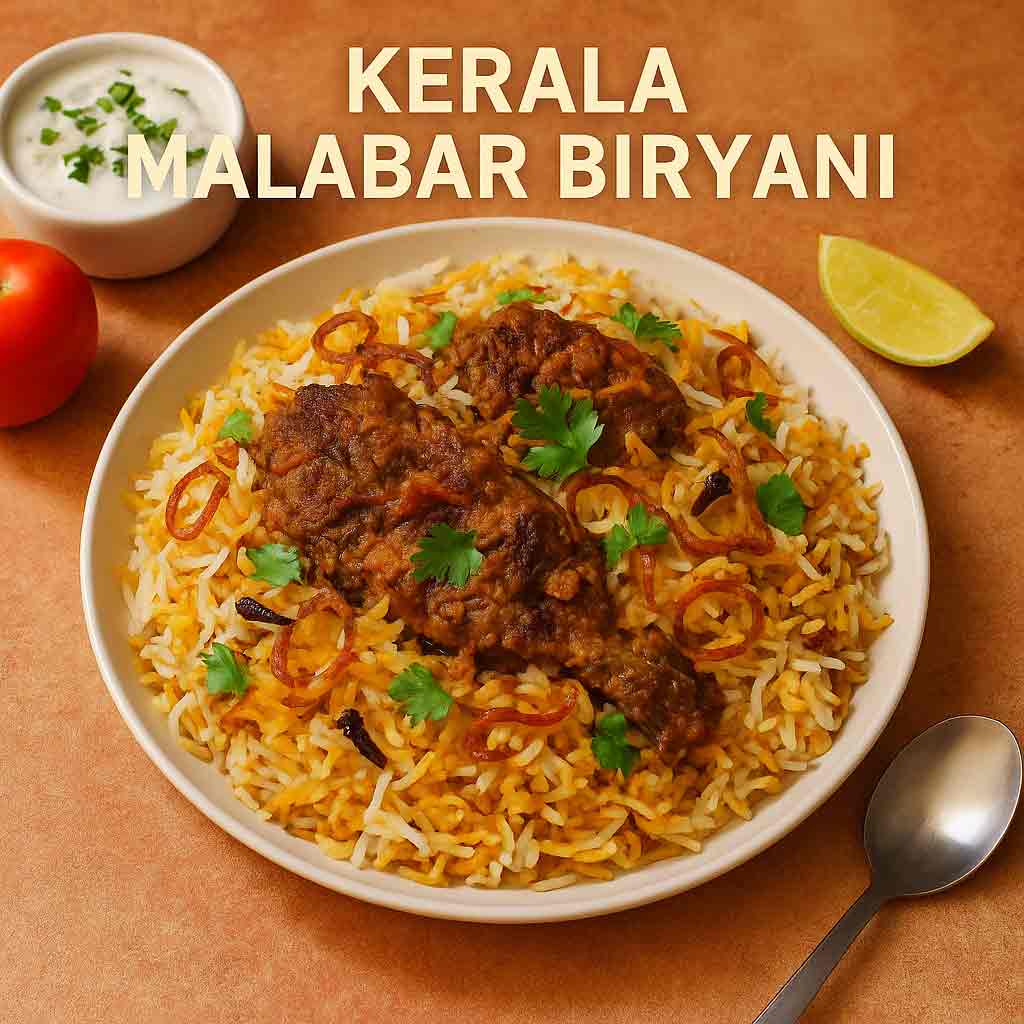
Kerala Malabar Biryani 🫕 Ingredients For the Rice: Jeerakasala rice (short-grain fragrant rice) – 2 cups(If unavailable, use basmati rice but reduce cooking time slightly) Ghee – 2 tbsp Whole spices – 4 cloves, 2 cardamoms, 1-inch cinnamon, 1 bay leaf Water – 3 cups Salt – as needed For the Chicken Masala: Chicken – 1 kg (bone-in, cleaned and cut) Onions – 3 large (thinly sliced) Tomatoes – 2 medium (chopped) Ginger-garlic paste – 2 tbsp Green chilies – 3 (slit) Yogurt – 3 tbsp Fresh coriander leaves – ½ cup (chopped) Fresh mint leaves – ½ cup (chopped) Cashew nuts – 10 (optional, for richness) Ghee / coconut oil – 4 tbsp Spices: Turmeric powder – ¼ tsp Red chili powder – 1½ tsp Coriander powder – 2 tsp Garam masala – 1 tsp Pepper powder – ½ tsp Salt – to taste For Garnish: Fried onions – 1 cup Fried cashews and raisins – 2 tbsp each Fresh coriander and mint leaves – a handful Ghee – 2 tbsp (for final drizzle) 🔪 Preparation Steps Step 1: Cook the Rice Wash and soak the rice for 20 minutes, then drain. Heat ghee in a large pan, add the whole spices, and sauté until aromatic. Add rice and fry gently for 2 minutes. Pour hot water and salt, cover, and cook until the rice is 90% done. Fluff gently and set aside. Step 2: Prepare the Chicken Masala Heat ghee or coconut oil in a thick-bottomed pan. Add onions and sauté until golden brown (this is key for deep flavor). Add ginger-garlic paste and green chilies; sauté till raw smell fades. Add tomatoes, chili powder, coriander powder, turmeric, pepper, and salt. Once oil separates, add chicken pieces and mix well. Add yogurt, mint, and coriander leaves. Cover and cook on medium flame until chicken is tender and masala thickens.Tip: The masala should be slightly dry — not watery. Step 3: Layer the Biryani In a heavy-bottomed pot, spread a thin layer of rice at the bottom. Add a layer of chicken masala. Repeat until all rice and masala are used, ending with rice on top. Sprinkle fried onions, mint, coriander, cashews, raisins, and a drizzle of ghee. Step 4: Dum (Steaming) Option 1: Stovetop Method Seal the pot with wheat dough or a tight lid. Place it on low flame for 15–20 minutes. Option 2: Oven Method Bake covered at 180°C (350°F) for 20 minutes. Let it rest for 10 minutes before opening. Step 5: Serve and Enjoy! Gently mix before serving, ensuring each portion has rice and chicken.Serve with: Raita (onion and cucumber yogurt mix) Pickle and papadam Sweet coconut halwa or banana chips (optional, for festive touch) 🌿 Chef’s Tips for Authentic Flavor Always use Jeerakasala rice for that distinct Malabar aroma. Fried onions (Birista) give depth and sweetness — don’t skip! Coconut oil can be mixed with ghee for that coastal essence. A few drops of kewra water or rose essence at the end can lift the aroma.
Kerala Karimeen Pollichathu
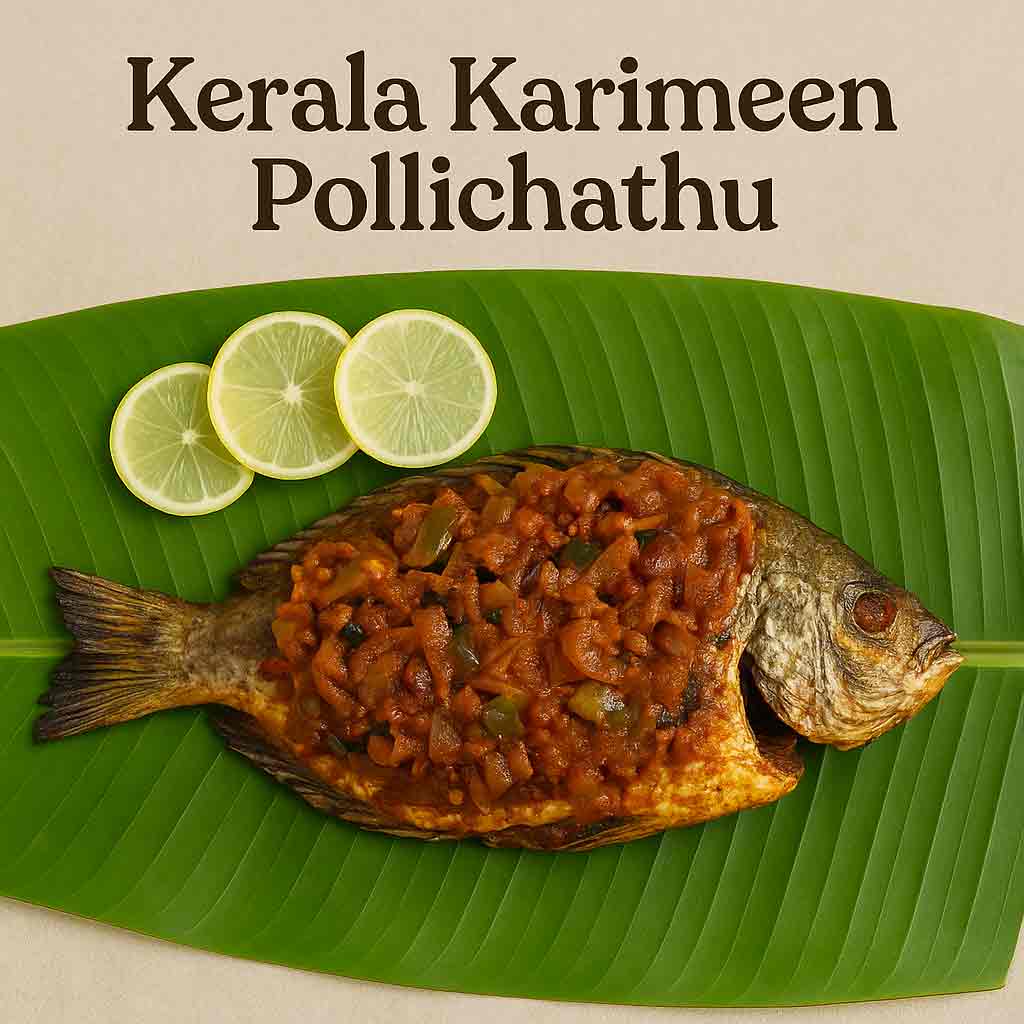
Kerala Karimeen Pollichathu 🐟 Ingredients For the Fish: Karimeen (Pearl Spot fish) – 2 medium-sized (cleaned and scaled) Lemon juice – 1 tbsp Turmeric powder – ¼ tsp Red chili powder – 1 tsp Salt – to taste Coconut oil – 2 tbsp (for shallow frying) For the Masala Filling: Onion – 2 large (finely chopped) Tomato – 2 medium (chopped) Green chilies – 2 (slit) Ginger-garlic paste – 1 tbsp Curry leaves – 10–12 Coconut oil – 2 tbsp Spices: Red chili powder – 1 tsp Coriander powder – 2 tsp Turmeric powder – ¼ tsp Pepper powder – ½ tsp Garam masala – ½ tsp Salt – to taste Other Ingredients: Tamarind pulp – 1 tbsp (or 2 small pieces soaked in warm water) Banana leaves – 2 large (wilted over a flame to make them pliable) 🔪 Preparation Steps Step 1: Marinate the Fish Clean and wash the Karimeen thoroughly. Make a few diagonal cuts on both sides of the fish. Rub a mix of lemon juice, chili powder, turmeric, and salt all over. Let it rest for 30 minutes to absorb the flavors. Step 2: Prepare the Masala Heat coconut oil in a pan. Add curry leaves, followed by onions and green chilies. Sauté until golden brown. Add ginger-garlic paste and sauté till the raw smell disappears. Add chili powder, coriander powder, turmeric, pepper, and garam masala. Add tomatoes and cook until the mixture turns thick and oil starts separating. Add tamarind pulp and salt. Simmer for 2–3 minutes till the masala becomes rich and glossy. Tip: The masala should be slightly tangy and spicy — adjust to taste. Step 3: Shallow Fry the Fish Heat coconut oil in a pan. Shallow fry the marinated fish for about 2 minutes on each side until it’s lightly golden — don’t overcook. Remove and place aside. Step 4: Assemble in Banana Leaf Place a banana leaf on a clean surface. Spread a layer of masala in the center. Place the fish on top and cover it fully with the remaining masala. Fold the banana leaf into a neat parcel and tie it with a banana fiber string or thread. Step 5: Steam or Pan-Roast Option 1 (Steaming): Steam the wrapped fish for 10–15 minutes. Option 2 (Pan-roast): Place the wrapped fish on a tawa, cover with a lid, and cook on low flame for 8–10 minutes each side until you smell the beautiful roasted aroma. Step 6: Serve Hot Unwrap carefully and serve the fish hot, straight from the leaf!The masala will be rich, smoky, and bursting with Kerala flavors. 🍋 Serving Suggestions Serve with steamed rice, kappa (tapioca), or Kerala parotta. Garnish with lemon wedges and curry leaves.
Kerala Sadya

Kerala Sadya 🌼 What is a Sadya? A Sadya is a traditional Kerala vegetarian meal served on a banana leaf, typically featuring 20 to 30 dishes. It represents the state’s culinary richness — a perfect balance of flavors: sweet, sour, salty, bitter, and spicy. 🍌 Banana Leaf Arrangement (Traditional Order) Sadya is always served on a banana leaf, with each dish placed in a specific spot.From the top left to right, you’ll find: Upper left: Pickles, banana chips, pappadam Center: Rice with curries (sambar, rasam, etc.) Bottom left: Banana or payasam (dessert) 🫕 Key Dishes in a Traditional Kerala Sadya 1. Matta Rice (Red Parboiled Rice) The base of Sadya — cooked soft and fluffy. To prepare: Wash and cook Kerala matta rice with water (1:3 ratio) until tender. Drain excess water if needed. 2. Sambar (Vegetable Lentil Curry) A thick, tangy curry made with toor dal, tamarind, and mixed vegetables like drumstick, pumpkin, and okra. To make: Cook toor dal till soft. Add boiled vegetables, sambar powder, tamarind pulp, salt. Simmer and finish with a mustard seed, curry leaf, and dry red chili tempering in coconut oil. 3. Avial (Mixed Vegetable Coconut Curry) A signature dish of Sadya — mildly spiced, coconut-based mixed vegetable curry. To make: Cook vegetables (raw banana, yam, beans, carrot) with salt and a bit of turmeric. Grind coconut, green chili, and cumin into a coarse paste. Mix with vegetables, add curd, and drizzle with coconut oil and curry leaves. 4. Olan (Ash Gourd and Black-eyed Beans Curry) A light, fragrant dish cooked in coconut milk. To make: Cook ash gourd and cowpeas until soft. Add thin coconut milk, salt, and green chilies. Finish with thick coconut milk and coconut oil. 5. Thoran (Vegetable Stir-Fry with Coconut) Dry dish — cabbage, beans, or carrot sautéed with grated coconut. To make: Stir-fry chopped veggies with mustard seeds, curry leaves, and green chilies. Add grated coconut and turmeric; cook till dry. 6. Kaalan (Yam and Raw Banana Curry with Yogurt) A tangy, thick curry made with curd, coconut, and pepper. To make: Cook yam and raw banana in water with turmeric and pepper. Add ground coconut-cumin paste and thick curd. Simmer till thick; temper with mustard, methi seeds, and curry leaves. 7. Erissery (Pumpkin and Black-eyed Pea Curry) Sweet-spicy dish — pumpkin mashed with beans and coconut paste. 8. Rasam (Spiced Tamarind Soup) A thin, spicy broth made with tamarind, tomatoes, and rasam powder — served toward the end for digestion. 9. Kichadi & Pachadi Yogurt-based side dishes: Pineapple Pachadi – sweet and tangy with grated coconut. Cucumber or Beetroot Kichadi – cooling yogurt side with mustard seasoning. 10. Payasam (Dessert) Every Sadya ends on a sweet note — often with two types: Palada Payasam – made with milk, ada (rice flakes), and sugar. Parippu Payasam – made with moong dal, jaggery, and coconut milk. 11. Accompaniments Pappadam – crispy fried lentil wafers Upperi (Banana chips) – sweet and salty versions Inji Puli (Ginger Tamarind Pickle) – spicy-sweet Kaalan / Moru Curry – yogurt curry poured over rice Banana – eaten at the end or with payasam 🍽️ Serving Order Serve all side dishes first on the banana leaf. Then add rice in the center. Pour parippu curry first, followed by sambar, and later rasam. End with payasam and a small banana. 🌿 Tips for Authentic Kerala Sadya Use fresh coconut for all dishes. Cook in coconut oil only. Serve on banana leaves with the narrow end pointing to the left. Sadya is traditionally eaten by hand, sitting cross-legged on the floor.
Kerala Puttu and Kadala Curry

Kerala Puttu and Kadala Curry 🥥 Puttu (Steamed Rice Cake) Ingredients Rice flour – 1 cup (puttu podi – coarsely ground rice flour) Grated coconut – ½ cup Salt – to taste Water – as required Instructions Prepare the rice flourLightly roast the rice flour on low flame for 3–4 minutes until it gives off a nutty aroma. Let it cool. Mix the flourAdd salt to the flour. Sprinkle water little by little and mix using your fingers until the flour becomes moist and crumbly.Tip: When you press the mixture between your fingers, it should hold shape but break apart easily — that’s the right texture. Layer and steamIn the puttu kutti (puttu maker), start by adding 1 tbsp of grated coconut at the bottom, followed by a layer of rice flour, then coconut again. Continue until the cylinder is full, ending with coconut. SteamPlace the puttu maker over the boiling water in the puttu pot and steam for about 5–7 minutes or until you see steam escaping from the top. Serve hotPush the steamed puttu onto a plate and serve hot with kadala curry or banana. 🌿 Kadala Curry (Black Chickpea Curry) Ingredients Black chickpeas (kala chana) – 1 cup Coconut (grated) – ½ cup Onion – 1 large (finely chopped) Tomato – 1 medium (chopped) Garlic – 4 cloves Ginger – 1 inch piece Green chilies – 2 (slit) Mustard seeds – ½ tsp Curry leaves – few Coconut oil – 2 tbsp Water – as required Salt – to taste For Spice Powder Coriander powder – 2 tsp Red chili powder – 1 tsp Turmeric powder – ¼ tsp Garam masala – ½ tsp Fennel seeds – ½ tsp Instructions Soak and cook the chickpeasWash and soak chickpeas overnight. Pressure cook with salt and enough water for 6–7 whistles or until soft. Roast the coconutIn a pan, heat 1 tsp coconut oil. Add grated coconut and roast till golden brown. Add a pinch of turmeric and roast for another minute.Cool and grind to a smooth paste with little water. Make the masala baseIn another pan, heat coconut oil. Splutter mustard seeds. Add curry leaves, chopped onion, green chilies, ginger, and garlic. Sauté till golden. Add spicesAdd coriander powder, chili powder, turmeric powder, fennel seeds, and garam masala. Fry for a few seconds till aromatic. Add tomatoAdd chopped tomato and cook till soft and mushy. Combine everythingAdd cooked chickpeas with the water, the roasted coconut paste, and salt. Simmer for 10–15 minutes until the curry thickens and flavors blend. Finish with coconut oil and curry leavesDrizzle a spoon of coconut oil and toss in a few curry leaves for the authentic Kerala aroma. 🍽️ Serving Suggestion Serve steaming hot puttu with spicy kadala curry — a heavenly combo!You can also serve with ripe banana or papadam for a traditional Kerala breakfast.
Goan Sweet & Sour Vegetables Recipe
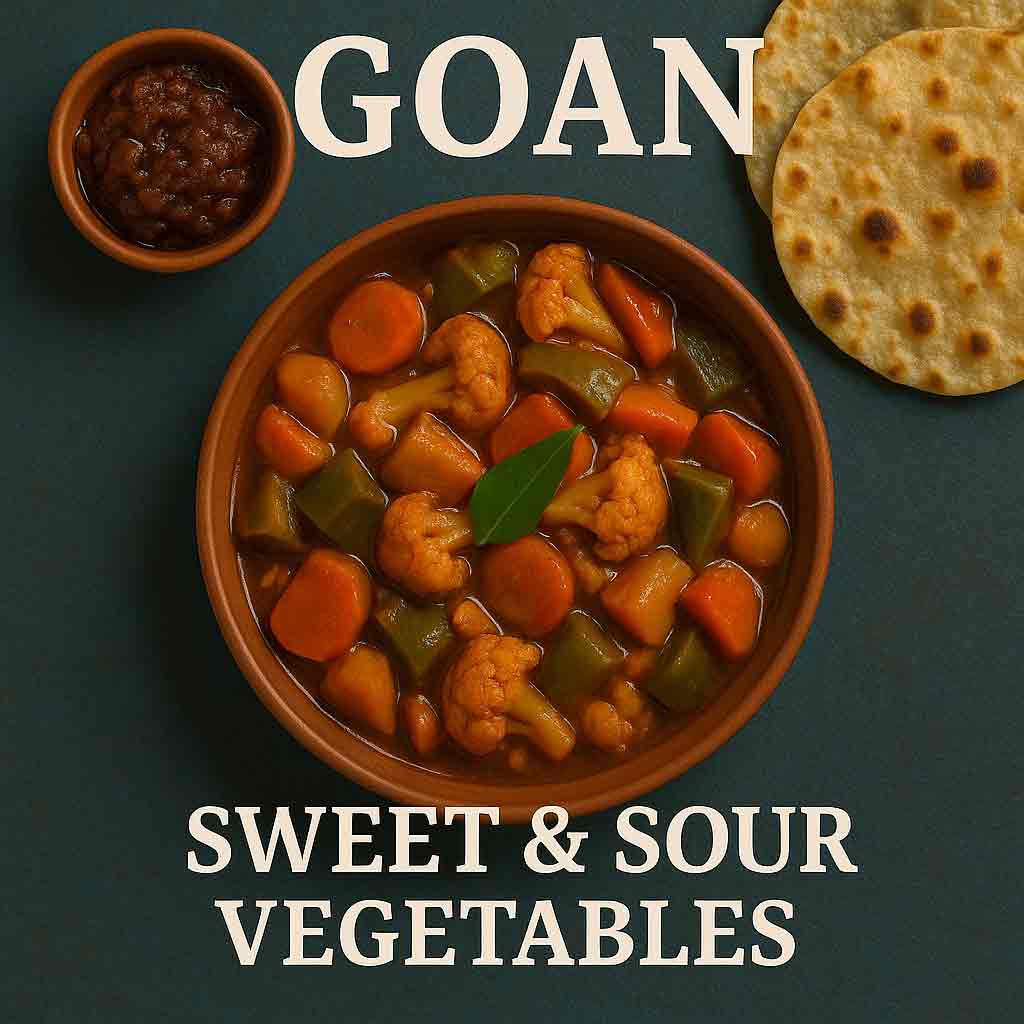
Goan Sweet & Sour Vegetables Recipe 🥘 Goan Sweet & Sour Vegetables Recipe Ingredients 🥦 For the Vegetables: 1 cup cauliflower florets 1 carrot, sliced 1 capsicum (bell pepper), diced 8–10 French beans, cut into 1-inch pieces 1 small potato, cubed ½ cup green peas (fresh or frozen) 2 tbsp oil (preferably coconut oil) Salt, to taste 🌶️ For the Masala Paste: 6–8 dried Kashmiri red chilies (for color and mild heat) 1 tbsp coriander seeds 1 tsp cumin seeds 4–5 black peppercorns 1 small stick cinnamon (1 inch) 4 cloves 1 tsp mustard seeds 6–8 garlic cloves 1-inch piece of ginger ½ tsp turmeric powder ½ cup grated coconut 1 tbsp tamarind paste or 2 tbsp vinegar 1 tbsp jaggery (or brown sugar) A little water, as needed for grinding 🍅 For the Curry Base: 2 medium onions, finely chopped 2 tomatoes, chopped 2 green chilies, slit 2 tbsp oil (coconut oil preferred) 1 cup water (adjust consistency) Salt, to taste Fresh coriander leaves, chopped (for garnish) Preparation Steps 🥬 Step 1: Parboil the Vegetables Boil 3 cups of salted water in a pan. Add carrots, potatoes, beans, and cauliflower. Parboil for 5 minutes — don’t overcook. Add peas and capsicum last, cook for 1–2 minutes. Drain and set aside. 🌀 Step 2: Prepare the Masala Paste Dry roast red chilies, coriander seeds, cumin, peppercorns, cloves, and cinnamon until fragrant. Grind them with mustard seeds, garlic, ginger, coconut, turmeric, tamarind/vinegar, and jaggery into a smooth paste. Add a little water if required. The paste should be thick and rich in aroma. 🍳 Step 3: Cook the Masala Heat 2 tbsp oil in a heavy-bottomed pan. Add onions and sauté till golden brown. Add green chilies and tomatoes; cook till the tomatoes turn soft and mushy. Add the ground masala paste and fry for 5–7 minutes until the oil separates and the raw spice smell disappears. 🥕 Step 4: Add Vegetables & Simmer Add the parboiled vegetables to the masala. Mix gently so the veggies are well-coated with the masala. Add water to adjust the gravy consistency. Add salt and simmer for 10–15 minutes on low flame. Taste and adjust balance — add a little more jaggery or vinegar if needed for that perfect sweet–sour–spicy Goan flavor. 🌿 Step 5: Serve Garnish with fresh coriander leaves. Serve hot with: Steamed rice Goan sannas Pav or poi 💡 Tips & Variations You can add pineapple pieces for a tropical twist. 🍍 To make it richer, add a few tablespoons of thick coconut milk at the end (optional). The curry tastes even better the next day as the flavors deepen. For a vegan option — this dish is already naturally vegan! 🌱
Goan Brinjal Bethaji Recipe
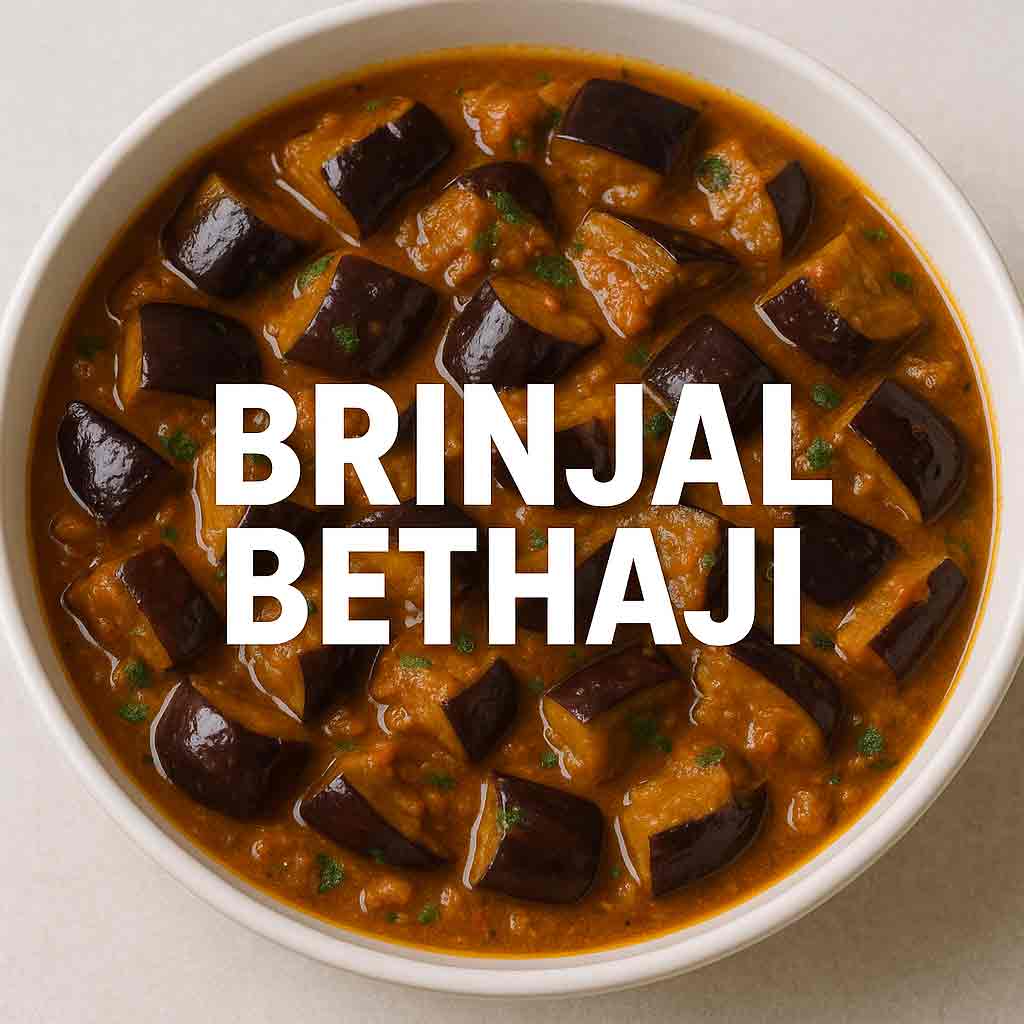
Goan Brinjal Bethaji Recipe 🥘 Goan Brinjal Bethaji Recipe (Goan Baingan Curry) Ingredients 🌶️ For the Masala Paste: 6–8 dried Kashmiri red chilies (for color and mild spice) 1 tbsp coriander seeds 1 tsp cumin seeds 1 tsp black peppercorns ½ tsp mustard seeds ½ tsp turmeric powder 6–8 garlic cloves 1 small piece ginger (1 inch) ½ cup grated fresh coconut 1 small marble-sized ball of tamarind (or 1 tbsp tamarind paste) ¼ cup vinegar (optional — adds a typical Goan tang) A little water to grind 🍆 For the Curry: 250–300 g small purple brinjals (eggplants), slit lengthwise but kept intact 2 medium onions, finely sliced 1 medium tomato, chopped 2 green chilies, slit 2 tbsp coconut oil (for authentic Goan flavor) Salt to taste ½ tsp jaggery (optional) — balances tanginess 1–1½ cups water (adjust to desired consistency) Preparation Steps 🔥 Step 1: Prepare the Brinjals Wash and slit each brinjal lengthwise into quarters (don’t cut through completely). Sprinkle with a little salt and set aside for 10–15 minutes. Heat 1 tbsp oil in a pan and lightly fry the brinjals until they soften slightly. Remove and set aside. 🌀 Step 2: Make the Masala Paste Dry roast red chilies, coriander seeds, cumin, peppercorns, mustard seeds, and coconut separately until fragrant. Grind all roasted ingredients with ginger, garlic, turmeric, tamarind, and vinegar into a smooth, thick paste. Add a few tablespoons of water if needed while grinding. 🍳 Step 3: Cook the Curry In the same pan, heat 1 tbsp coconut oil. Add onions and sauté until golden brown. Add tomatoes and green chilies. Cook until the tomatoes soften. Add the ground masala paste and fry for 5–6 minutes, stirring until the oil separates. Add water, salt, and jaggery (if using). Bring to a gentle simmer. Carefully add the partially fried brinjals to the masala. Cover and cook on low flame for about 10–15 minutes, until the brinjals are tender and the curry thickens. 🌿 Step 4: Serve Garnish with fresh coriander leaves. Rest for 10 minutes before serving — the flavors deepen beautifully. 🍽️ Serving Suggestions Serve hot with: Steamed Goan rice Goan poi or pav Sannas (Goan steamed rice cakes) 💡 Tips & Variations You can replace vinegar with kokum for a coastal twist. Add 1–2 tbsp roasted peanuts or cashews to the masala for a nutty flavor. The curry tastes even better the next day — once the brinjal soaks up the tangy masala.
Goan Liver Curry Recipe

Goan Liver Curry Recipe 🥘 Goan Liver Curry Recipe (Goan Style Kaleja Masala) Ingredients For the Masala Paste: 8–10 dried Kashmiri red chilies (for color and mild spice) 1 tbsp coriander seeds 1 tsp cumin seeds 1 tsp black peppercorns 4–5 cloves 1 small piece cinnamon (1 inch) 1 tsp turmeric powder 6–8 garlic cloves 1-inch piece of ginger 2 tbsp vinegar (or tamarind pulp for a slightly tangy version) ¼ cup grated coconut (optional – adds richness) A little water to grind For the Curry: 500 gms liver (pork, chicken, or beef — traditionally pork or beef liver is used) 2 large onions, finely sliced 2 medium tomatoes, chopped 2 green chilies, slit 2 tbsp oil (preferably coconut oil for authentic flavor) 1 tsp salt, or to taste ½ tsp sugar or jaggery (balances spice) 1 cup water, or as needed Fresh coriander leaves, chopped (for garnish) Preparation Steps 🌀 Step 1: Clean & Prepare the Liver Wash the liver pieces well in cold water. Cut into small cubes or thin slices. Optionally, soak in a little vinegar or lemon juice for 10 minutes to remove any raw odor, then rinse and drain. 🧄 Step 2: Make the Masala Paste Dry roast the red chilies, coriander seeds, cumin, black pepper, cloves, and cinnamon lightly until aromatic. Grind with ginger, garlic, turmeric, vinegar, and grated coconut into a smooth paste. Add a few tablespoons of water if needed while grinding. 🍳 Step 3: Cook the Curry Heat oil in a pan. Add the onions and sauté until golden brown. Add the tomatoes and green chilies. Cook until the tomatoes soften and oil separates. Add the ground masala paste and fry for 5–7 minutes on medium flame until the raw smell disappears. Add the liver pieces and stir well to coat them with masala. Add salt and a splash of water (just enough for a thick gravy). Cover and cook for 10–12 minutes, stirring occasionally. Do not overcook the liver — it can become tough and grainy. Add a pinch of sugar or jaggery to balance the tangy-spicy flavor. 🌿 Step 4: Garnish & Serve Garnish with fresh coriander leaves. Let it rest for 10 minutes before serving — this allows the flavors to settle beautifully. 🍽️ Serving Suggestions Serve hot with: Goan poi (bread) or pav Steamed rice Goan sannas Or roti/paratha 💡 Tips & Variations For a richer taste, add a tablespoon of coconut milk at the end. For extra spice, add one more green chili or a bit of Goan red chili powder. The curry tastes even better the next day once the masala infuses the liver fully.
Goan Pork Vindaloo Recipe
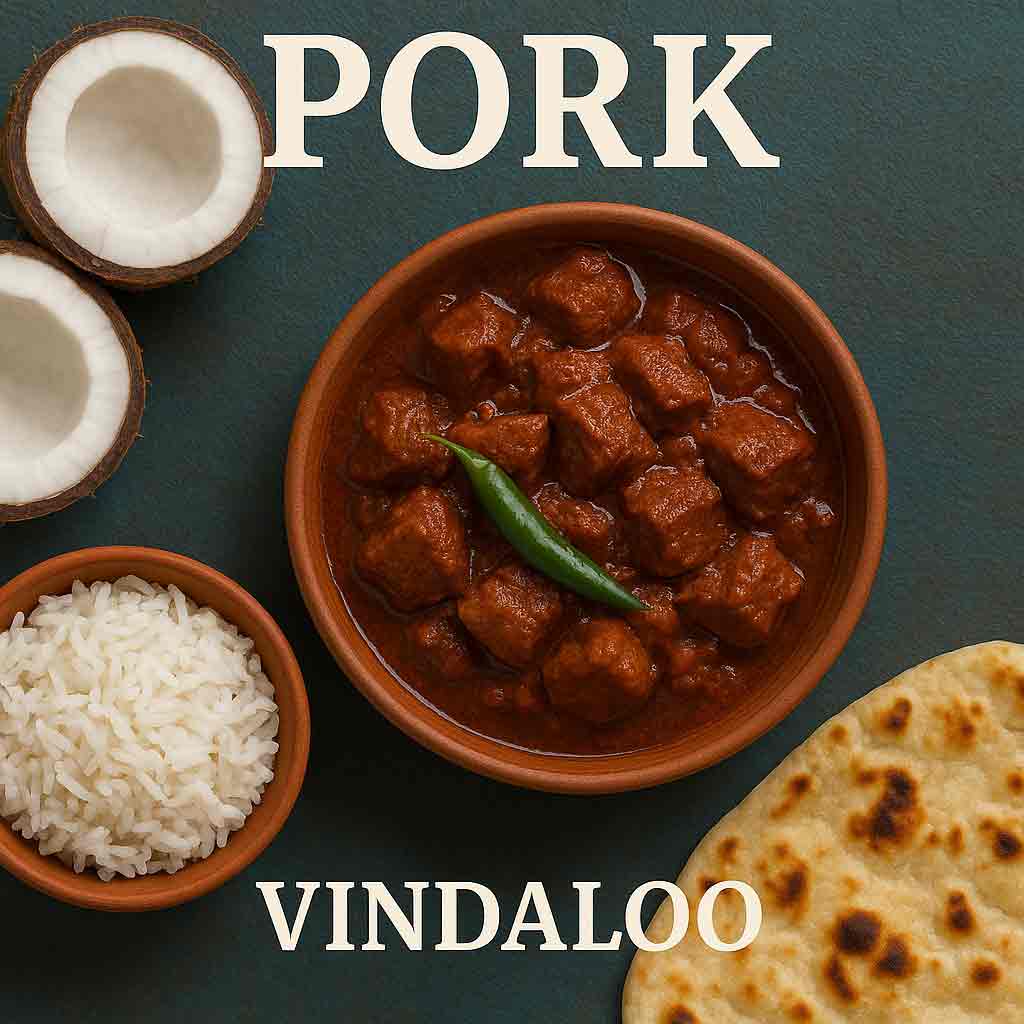
Goan Pork Vindaloo Recipe PORK VINDALOO Ingredients: 1 kg tender Pork5 small Potatoes2 Cloves4 Whole pepper2 green Cardamoms5 slit Green chillis1 tsp Sugar2 large Onions chopped4 tbsp Vinegar (brown)Salt to tasteGrind together 1″ piece Cinnamon1/2 tsp Cumin seeds1 tsp Coriander seeds1 tsp Turmeric powder3 cloves Garlic1″ piece Ginger6 Red chillis4 tbs Oil Preparation Steps 🌀 Step 1: Make the Masala Paste Soak the dried red chilies in warm water for 10–15 minutes. Grind all the masala ingredients (including soaked chilies, spices, garlic, ginger, and vinegar) into a smooth paste. Add a little water only if needed. The paste should be thick and aromatic. 🥩 Step 2: Marinate the Pork In a large bowl, mix the pork pieces with the masala paste and salt. Cover and marinate for at least 6 hours or overnight in the refrigerator. The longer it marinates, the deeper the flavor. 🍳 Step 3: Cook the Vindaloo Heat oil in a heavy-bottomed pot or pan. Add the onions and sauté until golden brown. Add the chopped tomatoes and cook until soft and mushy. Add the marinated pork with all the masala. Stir well to coat the meat with the masala. Cover and cook on low flame for about 45–60 minutes, stirring occasionally. Add water little by little to adjust consistency. Once the pork is tender and oil separates from the gravy, add sugar/jaggery to balance the taste. 🔥 Step 4: Let it Rest Vindaloo tastes best the next day — once the spices and vinegar mellow and blend beautifully. Serving Suggestions Serve hot with: Goan sannas (steamed rice cakes) Steamed rice Pav or bread Or even parathas 💡 Tips & Variations For milder spice: reduce the number of red chilies or deseed them. For richer flavor: use a mix of pork shoulder and belly. For a traditional touch: cook in clay pot and palm vinegar if available.
